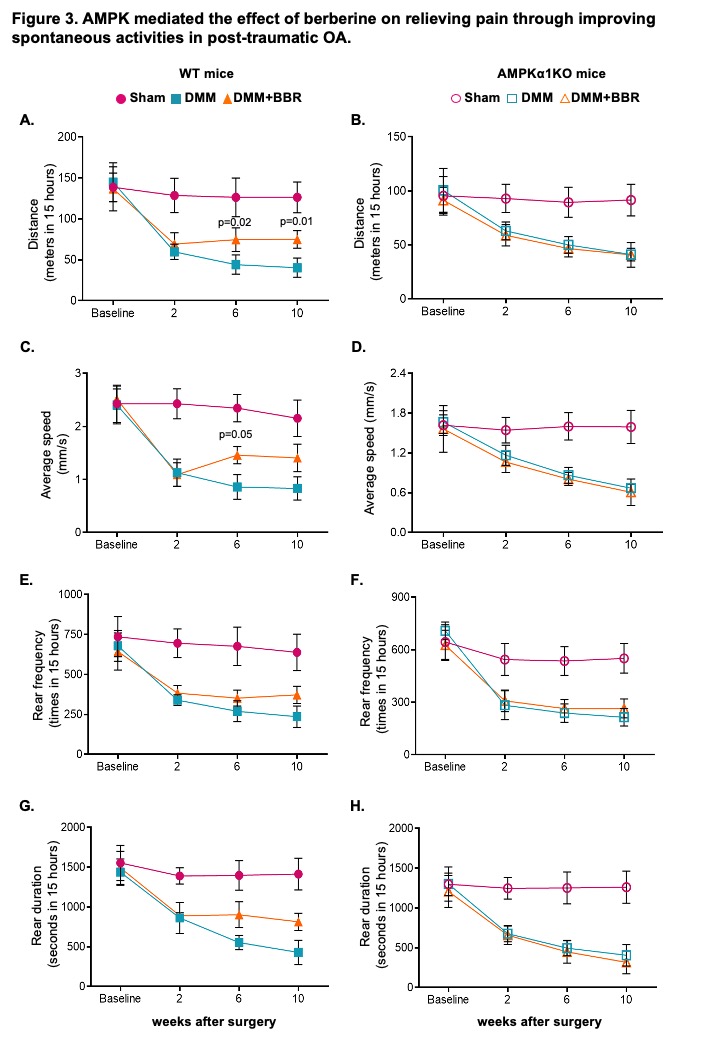Session Information
Date: Tuesday, November 9, 2021
Title: Osteoarthritis & Joint Biology – Basic Science Poster (1468–1479)
Session Type: Poster Session D
Session Time: 8:30AM-10:30AM
Background/Purpose: AMP-activated protein kinase (AMPK), a master regulator of energy balance and metabolism, is implicated to play an important role in cartilage homeostasis. Berberine is an isoquinoline alkaloid extracted from plants with low toxicity. It has anti-microbial, anti-inflammatory and anti-oxidant properties. The beneficial effect of berberine is mediated through multiple signaling pathways, and activation of AMPK is through to be one of the main actions of berberine. Although berberine exhibits chondroprotective effect, the underlying mechanism is not fully understood. In addition, whether berberine has ability to alleviate OA-associated pain remains unclear. Thus, in this study, we investigated the effect of berberine on OA development and associated pain in mice in vivo.
Methods: Human primary knee chondrocytes were included to investigate how AMPK is activated by berberine in vitro. Both global knockout (KO) of AMPKa1 and congenic wild type (WT) male mice were subjected to the post-traumatic OA through destabilization of medial meniscus (DMM) surgery. Two weeks after surgery, the mice were divided into two groups with one group receiving berberine chloride daily via drinking water. They were sacrificed at 6 and 12 weeks after surgery. OA severity was assessed by histological analyses of cartilage damage using the OARSI score system. Articular cartilage area of medial tibia plateau was quantified by tracing the Alcian blue-positive staining areas using the OsteoMeasure system. The osteophyte formation was evaluated semi-quantitatively based on both size and maturity of osteophytes. Immunohistochemistry (IHC) analyses were carried out to examine AMPK signaling. Pain behavior was evaluated by von Frey filament test to assess pain sensitivity. The Laboratory Animal Behavior Observation Registration and Analysis System was used to assess spontaneous pain behavior. GraphPad PRISM 8 was used for statistical analyses.
Results: Berberine induced phosphorylation of AMPKa (Thr172) via liver kinase B1 (LKB1), the major upstream kinase of AMPK, in chondrocytes
in vitro. Both WT and AMPKa1KO exhibited OA phenotype such as cartilage damage, osteophyte formation and associated pain
behavior, which progressed from mild to severe at 6 and 12 weeks post DMM surgery, respectively. Berberine treatment significantly reduced severity of OA and attenuated pain in WT but not AMPKa1KO mice, indicating the effect of berberine on chondroprotection and pain alleviation was AMPK-dependent. IHC analysis of WT mice revealed decreased phosphorylation of AMPKa (Thr172) and concomitantly reduced expression of SIRT1 and SIRT3 in situ in the DMM knee cartilage, which were significantly reversed by berberine. Stimulation human OA chondrocytes with berberine in vitro resulted in increased phosphorylation of AMPKa (Thr172), correlated with increased NAD+/NADH ratio and expression of NAD+-dependent SIRT1 and SIRT3, suggesting importance of activation of AMPK signaling in mediating beneficial effect of berberine.
Conclusion: Berberine acts through AMPK to reduce joint structural damage and alleviate pain associated with post-traumatic OA in mice in vivo, implicating its OA disease modifying potential.
 Both WT and AMPKa1KO mice were subjected to the DMM surgery to induce OA development. Two weeks after the surgery, mice in the treatment group started to receive berberine chloride via drinking water. At 6 and 12 weeks after the DMM surgery, mice were sacrificed and histological analysis of mouse knee sections (A) and assessment of cartilage damage including cartilage degradation (B and D) and cartilage area (C and E) were performed as described in the Methods. Two-way ANOVA with the post-hoc Tukey test was used for statistical analysis in B-E.
Both WT and AMPKa1KO mice were subjected to the DMM surgery to induce OA development. Two weeks after the surgery, mice in the treatment group started to receive berberine chloride via drinking water. At 6 and 12 weeks after the DMM surgery, mice were sacrificed and histological analysis of mouse knee sections (A) and assessment of cartilage damage including cartilage degradation (B and D) and cartilage area (C and E) were performed as described in the Methods. Two-way ANOVA with the post-hoc Tukey test was used for statistical analysis in B-E.
 The von Frey test was performed to assess pain sensitivity biweekly after DMM surgery (n=8, each group) in WT and AMPKa1 KO mice with and without berberine treatment as described in the Methods. Statistical analysis was conducted using two-way ANOVA with the Tukey post-hoc test.
The von Frey test was performed to assess pain sensitivity biweekly after DMM surgery (n=8, each group) in WT and AMPKa1 KO mice with and without berberine treatment as described in the Methods. Statistical analysis was conducted using two-way ANOVA with the Tukey post-hoc test.
 The LABORAS system was used to evaluate spontaneous pain biweekly after DMM surgery (n=4, each group) in WT and AMPKa1 KO mice with and without berberine treatment as described in the Methods, which included travel distance (A, B), average walking speed (C, D), rear frequency (E, F), and rearing duration (G, H). Statistical analysis was conducted using two-way ANOVA with the Tukey post-hoc test.
The LABORAS system was used to evaluate spontaneous pain biweekly after DMM surgery (n=4, each group) in WT and AMPKa1 KO mice with and without berberine treatment as described in the Methods, which included travel distance (A, B), average walking speed (C, D), rear frequency (E, F), and rearing duration (G, H). Statistical analysis was conducted using two-way ANOVA with the Tukey post-hoc test.
To cite this abstract in AMA style:
Li J, Wang Y, Chen D, Liu Bryan R. Oral Administration of Berberine Limits Post-traumatic Osteoarthritis Development and Associated Pain via AMP-activated Protein Kinase (AMPK) in Mice [abstract]. Arthritis Rheumatol. 2021; 73 (suppl 9). https://acrabstracts.org/abstract/oral-administration-of-berberine-limits-post-traumatic-osteoarthritis-development-and-associated-pain-via-amp-activated-protein-kinase-ampk-in-mice/. Accessed .« Back to ACR Convergence 2021
ACR Meeting Abstracts - https://acrabstracts.org/abstract/oral-administration-of-berberine-limits-post-traumatic-osteoarthritis-development-and-associated-pain-via-amp-activated-protein-kinase-ampk-in-mice/
